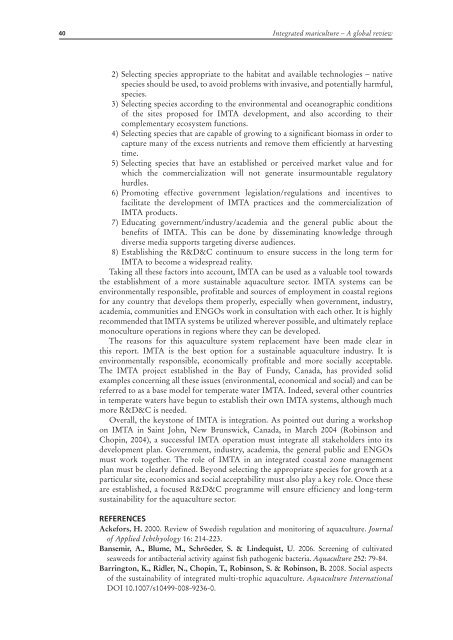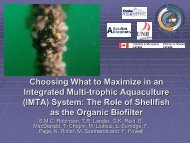Integrated multi-trophic aquaculture (IMTA) in marine temperate waters
Integrated multi-trophic aquaculture (IMTA) in marine temperate waters
Integrated multi-trophic aquaculture (IMTA) in marine temperate waters
You also want an ePaper? Increase the reach of your titles
YUMPU automatically turns print PDFs into web optimized ePapers that Google loves.
40<br />
<strong>Integrated</strong> mariculture – A global review<br />
2) Select<strong>in</strong>g species appropriate to the habitat and available technologies – native<br />
species should be used, to avoid problems with <strong>in</strong>vasive, and potentially harmful,<br />
species.<br />
3) Select<strong>in</strong>g species accord<strong>in</strong>g to the environmental and oceanographic conditions<br />
of the sites proposed for <strong>IMTA</strong> development, and also accord<strong>in</strong>g to their<br />
complementary ecosystem functions.<br />
4) Select<strong>in</strong>g species that are capable of grow<strong>in</strong>g to a significant biomass <strong>in</strong> order to<br />
capture many of the excess nutrients and remove them efficiently at harvest<strong>in</strong>g<br />
time.<br />
5) Select<strong>in</strong>g species that have an established or perceived market value and for<br />
which the commercialization will not generate <strong>in</strong>surmountable regulatory<br />
hurdles.<br />
6) Promot<strong>in</strong>g effective government legislation/regulations and <strong>in</strong>centives to<br />
facilitate the development of <strong>IMTA</strong> practices and the commercialization of<br />
<strong>IMTA</strong> products.<br />
7) Educat<strong>in</strong>g government/<strong>in</strong>dustry/academia and the general public about the<br />
benefits of <strong>IMTA</strong>. This can be done by dissem<strong>in</strong>at<strong>in</strong>g knowledge through<br />
diverse media supports target<strong>in</strong>g diverse audiences.<br />
8) Establish<strong>in</strong>g the R&D&C cont<strong>in</strong>uum to ensure success <strong>in</strong> the long term for<br />
<strong>IMTA</strong> to become a widespread reality.<br />
Tak<strong>in</strong>g all these factors <strong>in</strong>to account, <strong>IMTA</strong> can be used as a valuable tool towards<br />
the establishment of a more susta<strong>in</strong>able <strong>aquaculture</strong> sector. <strong>IMTA</strong> systems can be<br />
environmentally responsible, profitable and sources of employment <strong>in</strong> coastal regions<br />
for any country that develops them properly, especially when government, <strong>in</strong>dustry,<br />
academia, communities and ENGOs work <strong>in</strong> consultation with each other. It is highly<br />
recommended that <strong>IMTA</strong> systems be utilized wherever possible, and ultimately replace<br />
monoculture operations <strong>in</strong> regions where they can be developed.<br />
The reasons for this <strong>aquaculture</strong> system replacement have been made clear <strong>in</strong><br />
this report. <strong>IMTA</strong> is the best option for a susta<strong>in</strong>able <strong>aquaculture</strong> <strong>in</strong>dustry. It is<br />
environmentally responsible, economically profitable and more socially acceptable.<br />
The <strong>IMTA</strong> project established <strong>in</strong> the Bay of Fundy, Canada, has provided solid<br />
examples concern<strong>in</strong>g all these issues (environmental, economical and social) and can be<br />
referred to as a base model for <strong>temperate</strong> water <strong>IMTA</strong>. Indeed, several other countries<br />
<strong>in</strong> <strong>temperate</strong> <strong>waters</strong> have begun to establish their own <strong>IMTA</strong> systems, although much<br />
more R&D&C is needed.<br />
Overall, the keystone of <strong>IMTA</strong> is <strong>in</strong>tegration. As po<strong>in</strong>ted out dur<strong>in</strong>g a workshop<br />
on <strong>IMTA</strong> <strong>in</strong> Sa<strong>in</strong>t John, New Brunswick, Canada, <strong>in</strong> March 2004 (Rob<strong>in</strong>son and<br />
Chop<strong>in</strong>, 2004), a successful <strong>IMTA</strong> operation must <strong>in</strong>tegrate all stakeholders <strong>in</strong>to its<br />
development plan. Government, <strong>in</strong>dustry, academia, the general public and ENGOs<br />
must work together. The role of <strong>IMTA</strong> <strong>in</strong> an <strong>in</strong>tegrated coastal zone management<br />
plan must be clearly def<strong>in</strong>ed. Beyond select<strong>in</strong>g the appropriate species for growth at a<br />
particular site, economics and social acceptability must also play a key role. Once these<br />
are established, a focused R&D&C programme will ensure efficiency and long-term<br />
susta<strong>in</strong>ability for the <strong>aquaculture</strong> sector.<br />
REFERENCES<br />
Ackefors, H. 2000. Review of Swedish regulation and monitor<strong>in</strong>g of <strong>aquaculture</strong>. Journal<br />
of Applied Ichthyology 16: 214-223.<br />
Bansemir, A., Blume, M., Schröeder, S. & L<strong>in</strong>dequist, U. 2006. Screen<strong>in</strong>g of cultivated<br />
seaweeds for antibacterial activity aga<strong>in</strong>st fish pathogenic bacteria. Aquaculture 252: 79-84.<br />
Barr<strong>in</strong>gton, K., Ridler, N., Chop<strong>in</strong>, T., Rob<strong>in</strong>son, S. & Rob<strong>in</strong>son, B. 2008. Social aspects<br />
of the susta<strong>in</strong>ability of <strong>in</strong>tegrated <strong>multi</strong>-<strong>trophic</strong> <strong>aquaculture</strong>. Aquaculture International<br />
DOI 10.1007/s10499-008-9236-0.



